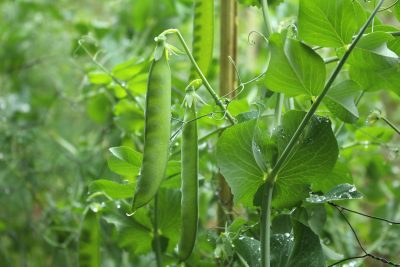Doing Good with Saw and Lopper
/4 Comments/in Flowers, Fruit, Gardening, Pruning/by Lee ReichFruitful Pruning
To begin, I gave the bush in front of me a once over, eyeing it from top to bottom and assuring it that the next few minutes would be all to its good. It was time for my blueberries’ annual pruning, the goals of which were to keep them youthful (the stems, at least), fecund, and healthy.
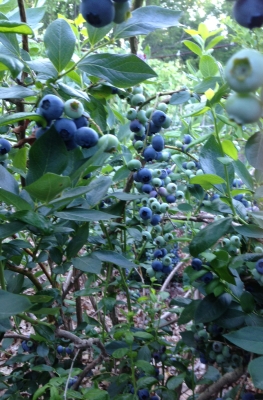
Blueberries galore
I peered in at the base of the plant, eyeing now the thickest stems. Blueberry bushes bear best on stems up to 6 years old, so the next move was to lop or saw any of these stems — usually only 3 or 4 of them, more on a neglected plant — as low as possible.
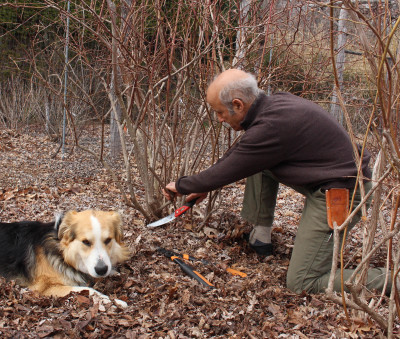
Sammy & me, pruning blueberries
To keep track of the ages of individual stems, I mark off the age of them each year with a Sharpie. Just kidding! The thickest ones are the oldest ones, and 6-year-old stems are generally an inch or more in diameter on healthy bushes.
Removing those stems that are over the hill frees up space for younger stems to develop. Each year blueberry bushes send up new sprouts from ground level, usually a few too many of them. They need to be thinned out so they don’t crowd each other as they age. I leave a half dozen or so of the most vigorous new sprouts, lopping all others to the ground.
That’s pretty much all there is to pruning a blueberry bush. With the very oldest and some of the very youngest stems cut to the ground, the bulk of pruning the bush is finished.
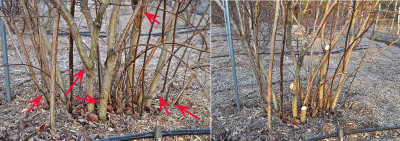
Blueberry bush, before & after pruning
I’ll also snip off any dead stems, remove a branch here and there where they are congested, and shorten any stems that will arch to the ground when laden with fruit.
That’s it. Finished, except to step back and admire my handiwork.
And Now, For Other Shrubs
The same pruning done on blueberry could, in essence, be applied to lilac,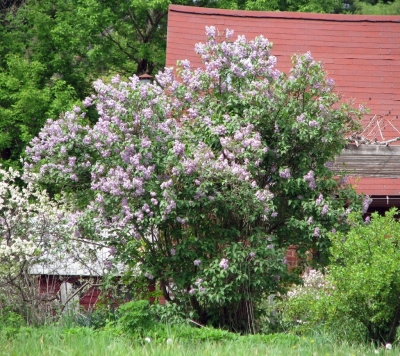 forsythia, mockorange, hydrangea, and any other informal shrub. This technique is known as rejuvenation pruning because, over time, the above ground portion of the shrub is annually rejuvenated. In the case of blueberry, the roots live unfettered year after year but the bush never sports stems more than 6 years old. A perennially youthful blueberry bush can go on like this, bearing well, for decades like this.
forsythia, mockorange, hydrangea, and any other informal shrub. This technique is known as rejuvenation pruning because, over time, the above ground portion of the shrub is annually rejuvenated. In the case of blueberry, the roots live unfettered year after year but the bush never sports stems more than 6 years old. A perennially youthful blueberry bush can go on like this, bearing well, for decades like this.
Not all shrubs perform best on stems up to 6 years old. Some, such as kerria, snowberry, rambling roses, and summer-bearing raspberries perform best on 1-year-old stems. So every year those 1-year-old stems are lopped to the ground and the youngest stems are thinned out.
Some shrubs, such as butterfly bush, everbearing raspberries, and red twigged dogwood, perform best on new stems. In this case, the whole plant gets lopped to ground level each year. (Everbearing raspberries actually bear on both new stems and on 1-year-old stems, so could be pruned as in the previous paragraph. That takes more time but does yield a midsummer crop on the 1-year-old stems and a late summer and fall crop on the new stems.)
At the other end of the spectrum in shrub pruning are witch hazel, tree peony , rose-of-sharon, climbing roses, and flowering quince. These shrubs are among those that perform well year after year on the same old, and always growing older, stems. They also grow few or no suckers each year. The upshot is that thesis shrubs are the easiest to prune: Don’t.
, rose-of-sharon, climbing roses, and flowering quince. These shrubs are among those that perform well year after year on the same old, and always growing older, stems. They also grow few or no suckers each year. The upshot is that thesis shrubs are the easiest to prune: Don’t.
I detail the ages of stems that are “keepers” for every shrub, plus other details in pruning all kinds of plants, in my book The Pruning Book.
Getting Formal
All this pruning refers to informal shrubs. For formal shrubs, such as the privet hedge near one edge of my yard, I put aside the lopper, pruning shears, and pruning saw, and get out the hedge trimmer. Shearing all the youngest twigs, working, this time, higher in the bushes rather than down near ground level, elicits repeated branching which results in dense growth.
To keep this formal hedge clothed from head to toe in leaves, I keep the row of plants narrower towards their upper portions. This lets sunlight beam down on the shrubs from top to bottom.
Northern Figs? Yes!
/24 Comments/in Fruit/by Lee ReichFaking The Subtropics
At first blush, the setting would not seem right for fig trees. There they were, in pots sitting on my terrace — so far so good — but with snow on the ground around them. Figs? Snow?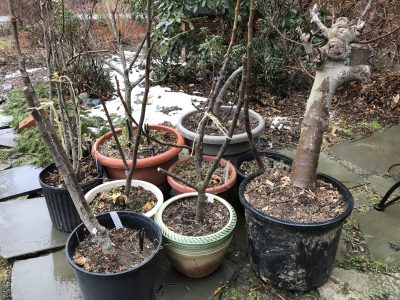
Figs seem so tropical but, in fact, are subtropical plants. And it does sometimes snow in subtropical regions. Climatewise, subtropics are defined as regions with mean temperatures greater than 50 °F with at least one month below about 64 °F. Further definitions exist but the point is that it does occasionally snow in subtropical regions; temperatures just never get very cold.
My potted figs couldn’t have survived our winters outdoors. They wintered in my basement, where winter temperatures are in the 40s. Cool temperatures are a must to keep the stored plants from waking up too early indoors, then, because the weather is too cold to move them outdoors, sprouting pale, sappy shoots in poor indoor light. Even sunny windows don’t hold a candle (pardon the pun) to sun in the great outdoors.
Sleep, Sweet Figs
My goal is to keep the plants asleep as long as possible and then to move them outdoors just as soon as temperatures are unlikely to plummet low enough to do them harm. I figure that date was yesterday, April 2nd. Most fig varieties tolerate cold down into the 20s, some even lower.
Roots of all plants have evolved in, of course, the ground, where temperatures are more moderate than the air. So they can’t tolerate as much cold as can stems. With cold penetrating the exposed soil in pots, more so the smaller the pot, I have to keep an eye on the outdoor temperature and, if it gets too low, whisk all the pots into the shelter of the garage.
In the ideal world, temperatures will slowly warm without any dramatic lows or highs, and fig buds will gradually unfold into shoots along whose length will develop and then ripen juicy, sweet Celeste, Genoa, Excel, Ronde de Bordeaux, and Rabbi Samuel figs.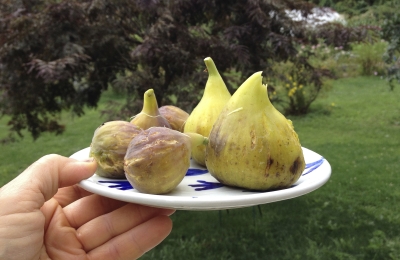
Cold concerns this time of year don’t apply to one of my potted figs, a Himalayan fig (Ficus palmata). I rooted a cutting of this plant a few years ago. It’s billed as being much more tolerant of both cold and summer rain than common figs (F. carica), both assets for a fig in this part of the world. I have yet to see fruit from this plant.
Primal Urges?
What is it about figs that makes so many people want to grow them? I know of someone in Sweden who grows them. Even someone in Canada who has a collection of over 200 varieties (www.adrianosfigs.com)! Figs are an ancient fruit with origins in the Fertile Crescent, so is it some primal connection with the distant past that is the attraction?
A big part of the attraction is, of course the flavor of fresh figs, which is unlike that of the dried fruit. Market figs don’t make the grade because figs have to be picked dead ripe for best flavor, at which point they’re too delicate to travel much further than arm’s length from plant to mouth.
As would be expected of so ancient a fruit, hundreds of varieties exist — and perhaps thousands of names because more than one name has been ascribed to many varieties. My variety Rabbi Samuel, for instance, mentioned above, is, I know a made-up name. 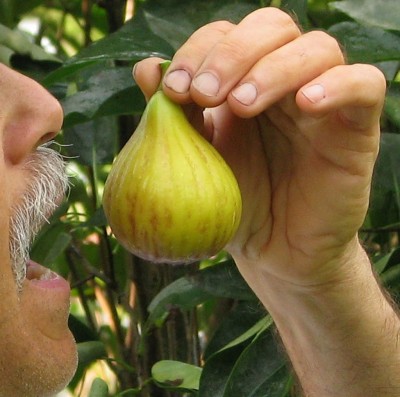 A friend made it up because he got it from some Hassidic Jews who had no name for it. And the frequently grown variety Brown Turkey is a name assigned to two different varieties, one more common on the west coast and the other more common on the east coast. And the east coast variety has a number of other names, including Everbearing, Texas Everbearing, and La Perpetuelle.
A friend made it up because he got it from some Hassidic Jews who had no name for it. And the frequently grown variety Brown Turkey is a name assigned to two different varieties, one more common on the west coast and the other more common on the east coast. And the east coast variety has a number of other names, including Everbearing, Texas Everbearing, and La Perpetuelle.
The first plant I ever grew once I got the gardening bug (in my 20s) was, in fact, Lee’s Perpetual (another name for eastern Brown Turkey). I grew it in a pot in a not very sunny window of the apartment I was renting. Not surprisingly, in retrospect, the plant never fruited.
Nowadays I think of the climate in which figs are native when growing my figs: cool, moist winters (as in my basement) and hot summers with plants baking in abundant sunlight. I now harvest plenty of figs.
Postscript April 6th: Temperatures of 22 °F perhaps prompted me awake at 3 am; I got up and lugged all 11 potted figs into the shelter of my unheated garage.
And The Season Begins . . .
/8 Comments/in Gardening, Vegetables/by Lee Reich
St. Patty’s Day Passed; No Matter
Uh oh! St. Patrick’s Day was way passed and I hadn’t planted my peas. No matter. St. Patty’s Day is the right time to plant peas in Virginia, southern Missouri, and other similar climates, including, probably, Ireland.
Around here, in New York’s Hudson Valley, where the average date of the last killing frost is sometime in the latter half of May, April 1st is more like it. That’s the date that I shoot for, at least. Some springs, like the spring of 2017, earlier plantings would have done better. But you never know what bodes for the weather, so playing the averages is the best bet.
The problem with planting pea seeds too early is that the seeds will just sit and perhaps rot in cold soil. The problem with planting peas too late is that temperatures are too hot when the plants are supposed to be in all their glory, so they peter out rather than bear well. Again, an April 1st planting date, around here, generally works best.
Soil temperature is an even better guide than calendar date; pea seeds germinate when the soil warms to 40°F. Or a phenological indicator; blossoms of spring-flowering trees and shrubs open in response to warmth. Forsythia blossoms are just about to open at about the same time that the ground has warmed to that 40° temperature.
Get ‘Em Up
Peas grow as vines anywhere from a foot and a half tall to more that 6 feet long. Whether short or long, the vines are not self supporting. The laissez faire gardener just lets the vines sprawl on the ground, then lifts them to harvest.
For a neater garden and cleaner pods, I trellis my peas. By exploiting a third dimension — up — I also reap more productivity per square foot of garden space from trellised peas.  Plus, if the peas are planted down the center of my 3-foot-wide garden beds, I can flank them with other vegetables, such as carrots, radishes, lettuce, and arugula.
Plus, if the peas are planted down the center of my 3-foot-wide garden beds, I can flank them with other vegetables, such as carrots, radishes, lettuce, and arugula.
Peas, like other vegetables, should be rotated around the garden, that is, not planted in the same place again within 3 years. Crop rotation avoids the buildup of pest problems that overwinter in the ground. Without their host plants, they starve.
With this caveat, peas need temporary trellising, trellising that can follow them around the garden. Traditional temporary trellising for peas, and very British, are pea sticks. Looking quite charming, this trellis is made by merely sticking brushy twigs into the ground along the pea row. Pruning off branches sticking out perpendicular to the row leaves a flat plane of twigs up which the clinging vines can clamber.
The traditional pea trellis takes some time to set up and requires some time gathering a lot of suitable twigs.
Second Best Pea Trellis
I opt for the “second best pea trellis” which starts out by my pounding an old piece of inch-thick iron plumbing pipe into the ground at each end of my pea row. The trellis itself is chicken wire, each end of which I weave onto the pipes. The chicken wire can then be cut to the length of the row, or excess roll can just be left standing just beyond the pipe. The chicken wire slides down the pipes most easily if kept almost parallel to the ground, so I attach one end partway on one pipe, then the other end partway on the other pipe, and keep going back and forth easing the mesh down to the ground.
At this point, the trellis is quite floppy. I strengthen it with some of those inexpensive, fiberglass posts sold for electric fencing, weaving one of these posts into the chicken wire every three feet or so and then pushing it into the ground.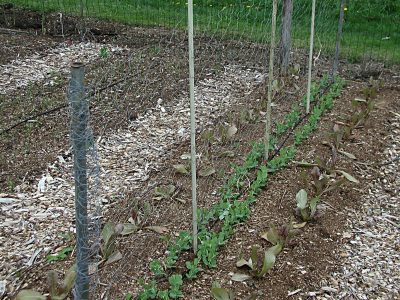
Presto! In about fifteen minutes, I’ve erected a serviceable and inexpensive pea fence. This fence can be erected just after the peas emerge through the soil, so what it lacks in beauty it makes up for by spending little time uncovered with pea vines. After pea harvest is over, I pull the vines down off the trellis and dismantle the fence in a reversal of the steps described. The fence, not being permanent, can move around the garden to a different location each spring — just as should the peas.